Hay nets are a an ideal feeding tool for many horses. If you know how to use a hay net, you can give your horse forage that lasts all day, helping with weight and mental health. But there’s a lot to know about using hay nets for horses, especially if you’ve never used a haynet before! If you want to give your horse a hay net but aren’t sure where to start, this article is for you. We’ll cover why hay nets are good for horses, how to pick the right hay net, and how to avoid common hay net problems.
What Is a Hay Net for Horses?
A hay net (sometimes spelled “haynet”) for horses a net bag or sack that holds forage. Hay nets come in a variety of materials, shapes, and sizes. Different kinds of nets meet your horses’ needs in different ways.
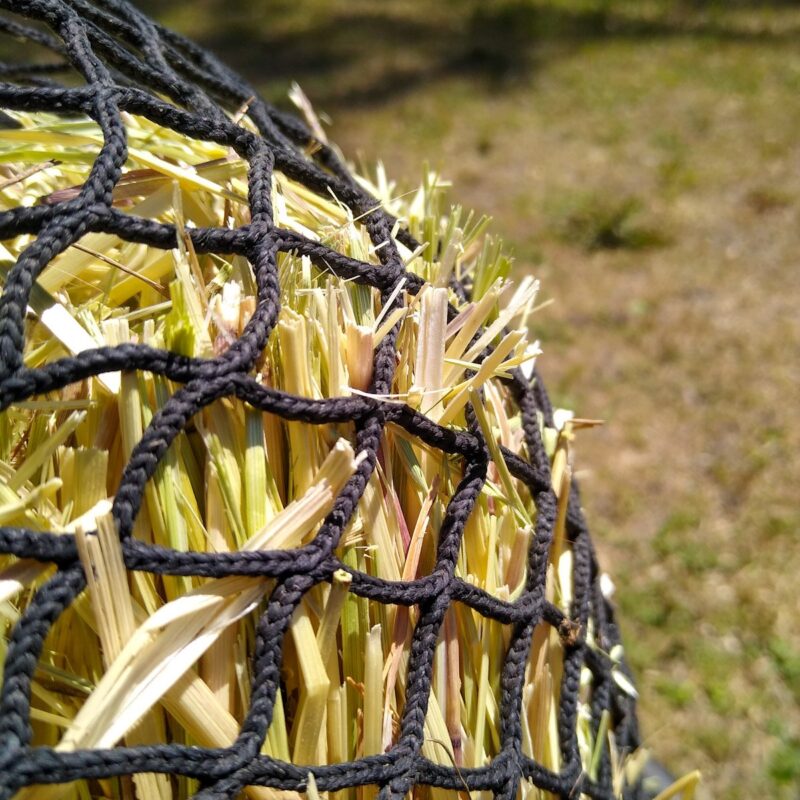
You can use a hay net anywhere you want to feed forage such as hay. Hay nets for horses come in many sizes, from small pillow-sized bags to enormous nets that can swallow a whole round bale.
Hay nets can be rounded and baglike or square and boxy. You can find hay nets made from different kinds of cord and with various knots. Most importantly, hay nets for horses come in many hole sizes, with mesh openings from 4 or more inches to half an inch. The most important considerations in your search for a hay net are the size of the net and the size of the mesh openings. Hay net size determines how much forage your net holds, and mesh size affects how quickly or slowly your horse eats.
Reasons to Use a Hay Net for Horses
Hay nets offer LOTS of benefits for horses – and for you!
Benefits of hay nets for you include keeping your hay in one place and greatly reducing waste. Your horse can’t step on the hay or pick through a pile and ignore most of the forage. They help you give exactly the right amount of hay for your horse’s needs. Hay nets control food intake for horses who need to lose or maintain their weight.
Benefits of hay nets for horses are better physical and mental health. Hay nets for horses are a form of equine enrichment because they encourage natural feeding behaviors. They give your horse the opportunity to graze. Keeping food available to horses at all times is an important part of good horse welfare, and reduces stress and food anxiety.
As an extra benefit, you can use several hay nets at once to set up feeding stations. Placing more than one hay net in a pasture invites your herd to get exercise moving between the nets, and reduces competition.
Where are the Best Places to Use Hay Nets for Horses?
You can use hay nets anywhere that you want to give your horse forage. The location of the net affects what type you should buy.
The stall is the first place to consider using a hay net for horses. It’s often the best way to ensure access to forage in a confined environment. It’s crucial for your horse’s mental and physical health to have forage available when they’re in a stall. Hay nets keep the hay clean and can slow down feeding so that the forage never runs out.
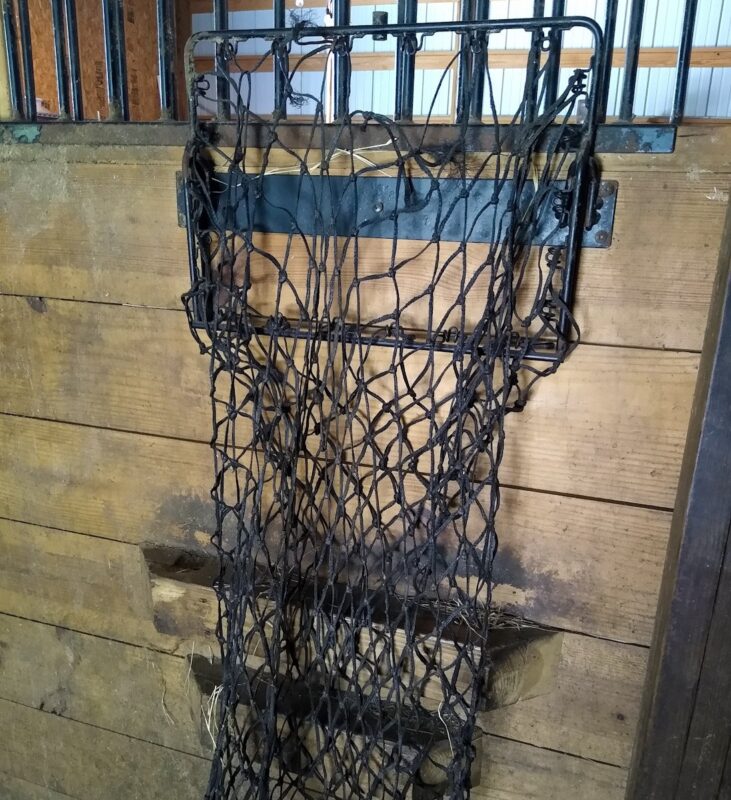
Hay nets are also a great option for pasture use. Even in pastures with ample grass, providing additional hay can provide dietary variety and keep grass from being overgrazed. For horses that can’t have abundant grass, hay nets in drylots or on tracks provide the necessary forage for digestive and behavioral health. You can place hay nets in strategic locations to create resource stations throughout your horse’s space.
There are other locations where your horse can benefit from a hay net. You can transport horses with a hay net in their float or trailer to keep them occupied during the ride, and use netted hay near arenas or at trailheads if there are periods where horses will need to wait before starting a ride or other activity.
Which Hay Net is Best for Horses?
Before you can pick a brand or retailer, you’ll need to decide what size and style of hay net you need. The main points to consider are how much hay you plan to place in the net and how big the mesh openings are.
What Material for Your Horse’s Hay Net?
Hay nets come in both natural and synthetic material.
Natural rope hay nets for horses are usually made from cotton. They have the advantage of being softer on equine teeth. Cotton hay nets are also a good choice if you’re looking to reduce your impact on the environment by using less plastic.
On the minus side, cotton nets are a little easier to tear apart than synthetic nets. They’re a good choice for horses who are gentle with their hay nets.
Synthetic rope hay nets for horses are made from a synthetic cord like polypropylene or nylon. They are very durable. The rope also has a slightly slick surface, which can make filling the net easier.
Synthetic rope hay nets do gradually break down when exposed to sunlight. When this happens, the hay net becomes less durable and may develop holes. They’re still the best choice for horses who need a very sturdy hay net, or for use in wet areas.
What Size Hay Net Does My Horse Need?
Standard size hay nets are about the same size as a bag of feed and hold several flakes or pads of square-baled hay. The exact capacity varies from net to net, but most can easily hold twenty or more pounds of hay – enough for a day or more of forage depending on how fast the horse eats. Average-sized hay nets are easy to find online or in tack or feed stores.
Larger hay nets are available that can hold an entire square bale or even a round bale, allowing you to get the benefits of hay net use without the need to fill a net once a day or more. When multiple horses need hay, these large nets can really save you time and money in forage.
Big nets are a specialty item that you’ll probably need to buy online. Many owners swear by Hay Chix brand whole bale hay nets.
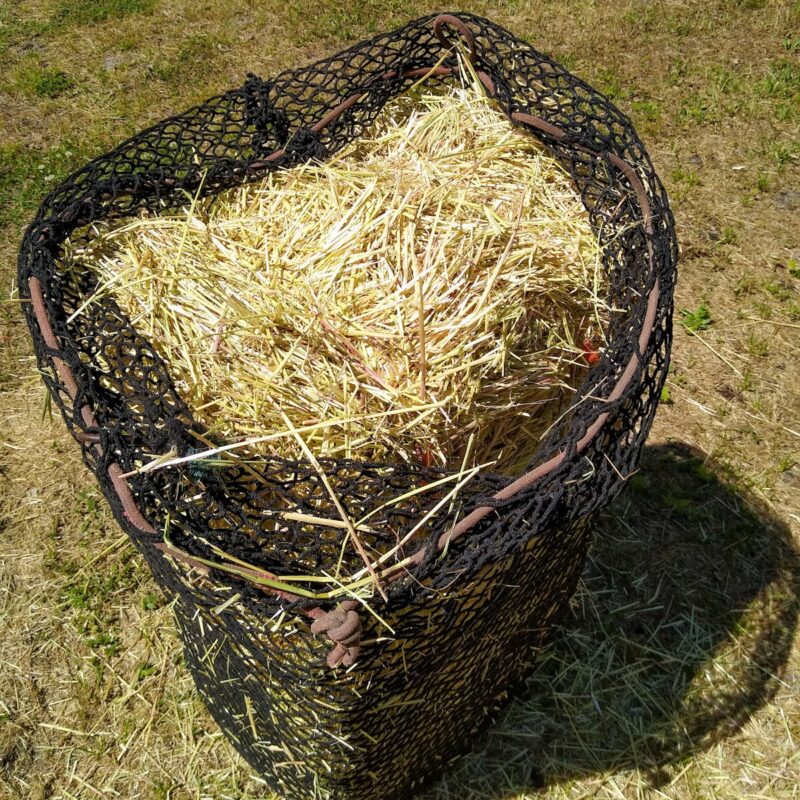
What Mesh Size For Your Horse’s Hay Net?
The standard hay net has a mesh opening size of about 2 inches/5cm. This is a good middle-of-the road size, especially for horses who need a bit less restriction on the amount of hay they eat. If your horse is a slow eater, this might be the perfect size.
Use a larger size opening (3 or even 4 inches) if your horse needs easy hay access. These hay nets are best if you want to avoid hay waste but need your horse to get plenty of hay. They will empty out faster than other nets.
If your horse does need a slower rate of feeding, you’ll need a net with smaller holes. Small hole hay nets are best for horses who need weight control. They let you provide 24/7 forage access but keep calories in check.
Mesh openings for these nets are as small as one half inch, but most brands stop at ¾” opening size. This size is very small and, if the horse uses the net properly, ensures that they consume forage in a slow trickle.
Smaller openings also reduce the rate of feeding with fine-textured hays such as coastal Bermuda, which sometimes has very short leaves that easily fall out of nets with larger openings.
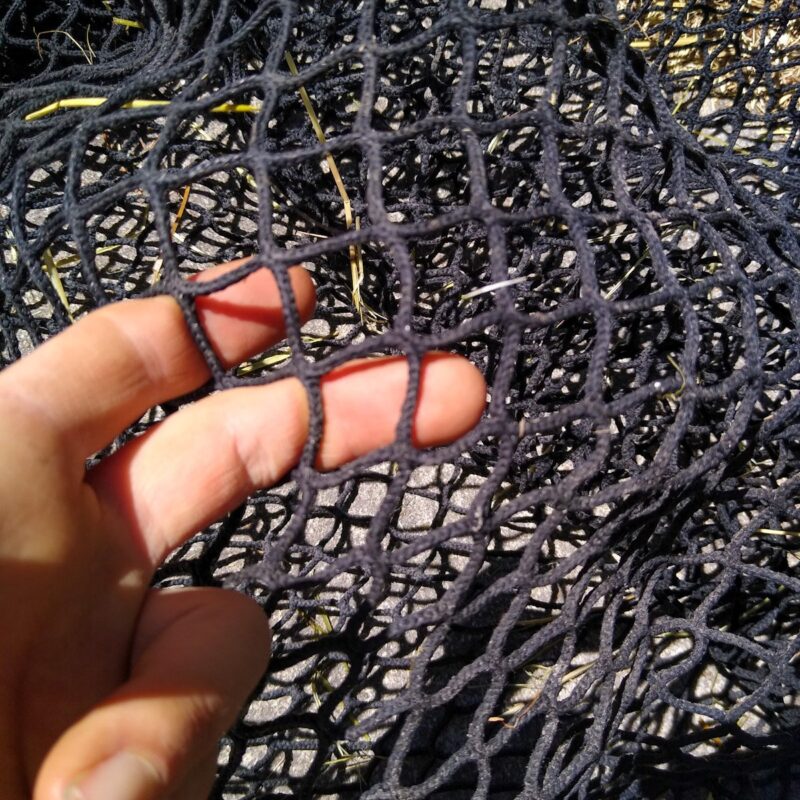
Where to Buy a Hay Net
Once you know what net you need, it’s time to buy! You can source hay nets online, buy in person from a store, or get a used one. Each option has pros and cons.
Buying a Hay Net Online
It’s easy to buy hay nets for horses online and your selection is almost unlimited. There can be so many different options from so many retailers that browsing for a hay net online can feel a little overwhelming.
It’s easier to buy online if you know exactly what you need. You can search for a precise size, shape, and hole diameter. Pricing of online hay nets varies widely and it’s possible to get good deals, but on the minus side, you won’t be able to examine the net’s quality in person.
Buying In a Store
Selection is more limited when shopping in person has benefits. At your local feed store, you can examine nets up close. Check the sizing of the holes, the thickness of the materials, and the quality of the knots.
It’s frustrating to spend money on any product and not have it meet your needs, so being able to check the net yourself instead of relying on an online description can set you up for hay net success.
Buying A Used Hay Net
You can get used hay nets for a fraction of the cost of new ones, with great results. But since the net has been used, it’s important to check it carefully for issues.
Exposure to the elements can weaken hay nets, so pull and tug on the net to ensure that it’s still in good shape. Unroll it completely to check for holes or tears. Buying used hay nets online from buy-and-sell groups can be a good budget option, but used tack sales and swaps let you see and feel the net for yourself before purchasing.
How to Buy a Quality Hay Net
Hay nets range in price. Just as with tack, you often get what you pay for! High quality nets that last longer and are easier to use are usually more expensive. At the same time, brand recognition comes into play – it’s possible to get great quality nets from lesser-known companies that are often less expensive than their big-name counterparts.
Part of hay net success can involve teaching your horse to use a small-hole net by gradually using nets with smaller holes. Go with a less expensive hay net for “training” purposes. When your horse is comfortable with their final hole size, it’s a good idea to invest in a high quality net.
When you get your hay net, open the packaging and check the net thoroughly. Make sure that it is free of defects. You want to look for missing or bad knots, fused or tangled material, and other problems before you use it.
Using Hay Nets for Horses: Filling and Closing
Filling up your horse’s hay net can be the least fun part of the process. Hay wants to go everywhere and nets always seem to collapse on themselves at the least convenient time. Filling nets for multiple horses in a stable can be a hassle, another reason to consider whole-bale nets.
You can load a square bale into a whole-bale net in seconds. Keep the twine on the bale and turn it on its end, fit the net over the top like a pillowcase, and pull downward. Then turn the bale over and remove the twine.
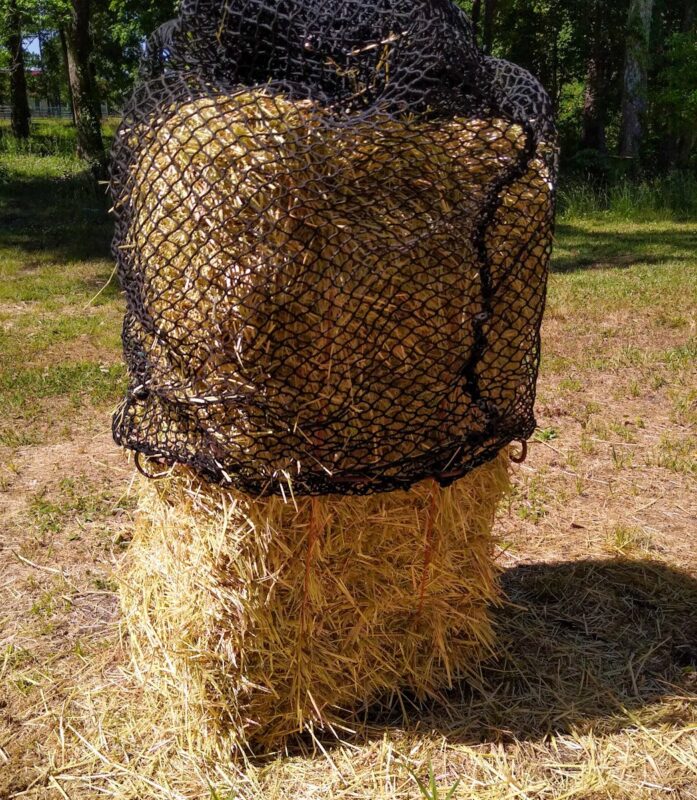
There’s no right or wrong way to fill a haynet. If you’re working with square bales of hay compressed into flakes it doesn’t matter whether the flakes are turned. Prop the net open with your foot, stretch out other end with one hand, and slip a flake of hay inside, or stuff in loose sheaves of hay. Once a few pounds of hay are in the net, it will stay open much better.
If you have to fill lots of hay nets for horses, consider making a hay net filling frame. A simple open box with hooks at the top will hold your net open for easy filling.
The most important thing to remember is to remove all baling twine from the hay before giving it to your horse. Baling twine sticking out of the hay net’s mesh is easily confused for forage.
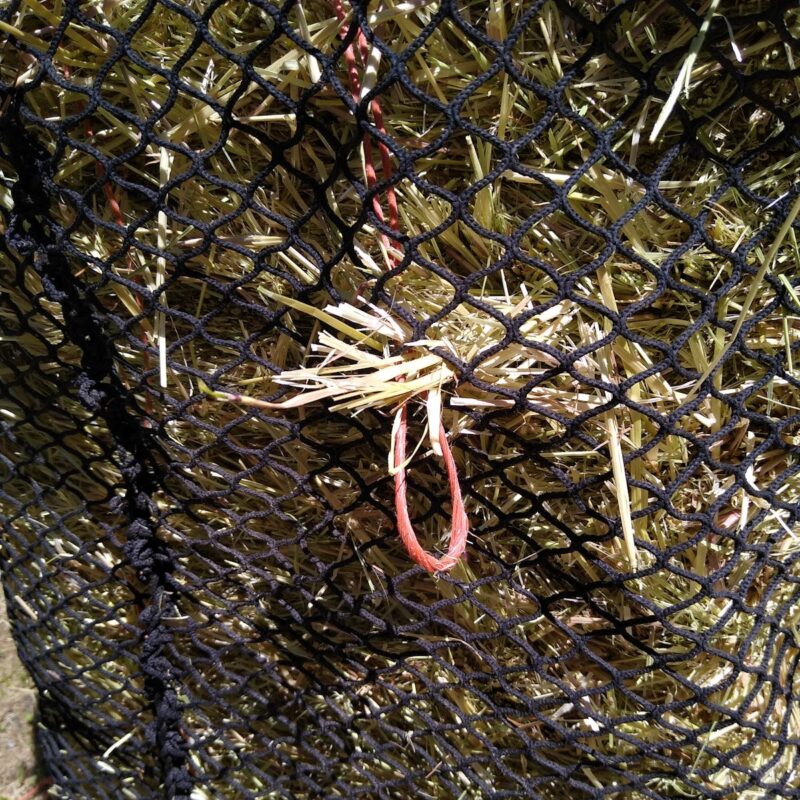
Most hay nets have a drawstring closure. When your net is full, make an overhand knot in the rope and snug it right against the net. This keeps your horse from opening the hay net.
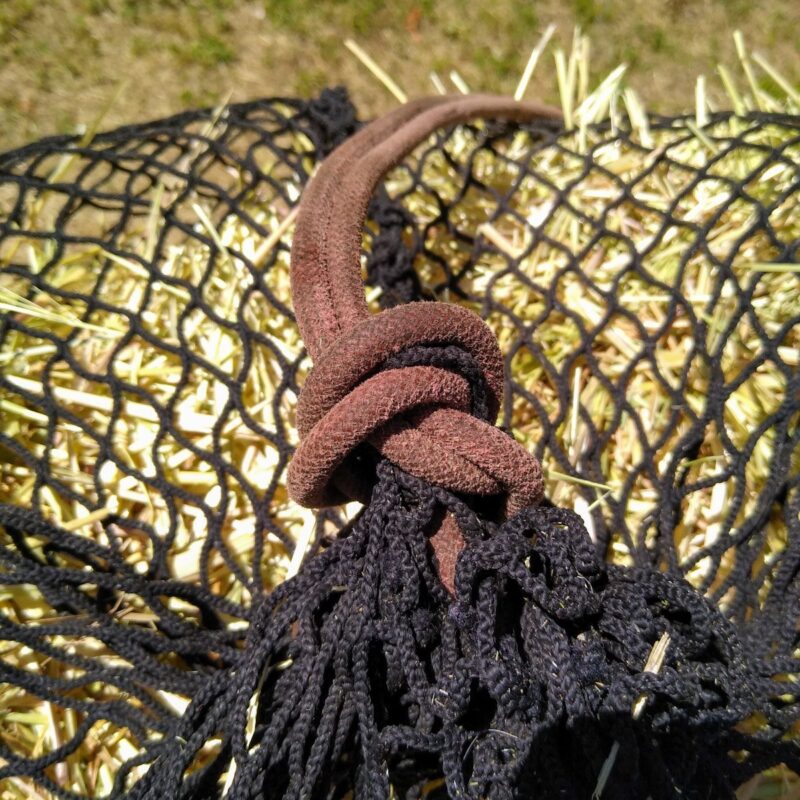
How to Secure Hay Nets for Horses
You can tie or clip a hay net to any sturdy location in the stall or pasture. Wooden walls, fence posts, and trees are all good options.
You can install your hay net in a variety of ways. The easiest is simply to tie the net by its drawstring to a sturdy structure such as a wooden fence post or wall of the horse’s shelter.
Tying up a net works well, but can be inefficient if you have many horses. Working with the knots is challenging in cold weather. And full hay nets can be unwieldy and hard to handle.
To make securing hay nets faster and easier, you can use tie rings. Install the same kind of ring as used for tying horses to handy pasture structures or stall walls. Tie ring fixtures designed for horses have safely rounded edges and are sturdy enough to handle a horse pulling tugging or pushing on the weighted haynet. You can attach the hay net to the ring using its drawstring or rope, or a clip.
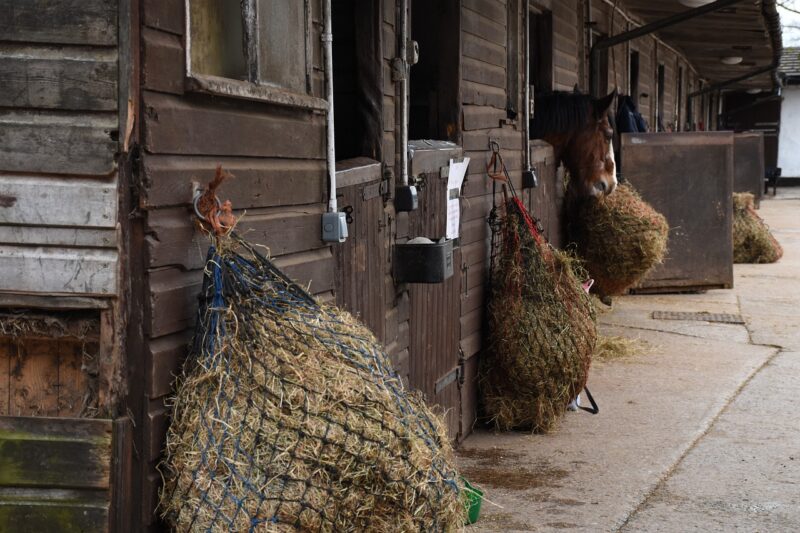
If using clips, it’s important to ensure that they have no sharp edges or protrusions. Don’t use clips when your horse wears a halter or other equipment.
Hay nets can also hang from a metal wall frame that you can buy online or in local agricultural stores. These require a section of wall and are permanent, but make loading hay a breeze. Hay net frames often come with a net provided, but you can install any net if you need to replace one or want a net with smaller holes for your horse.
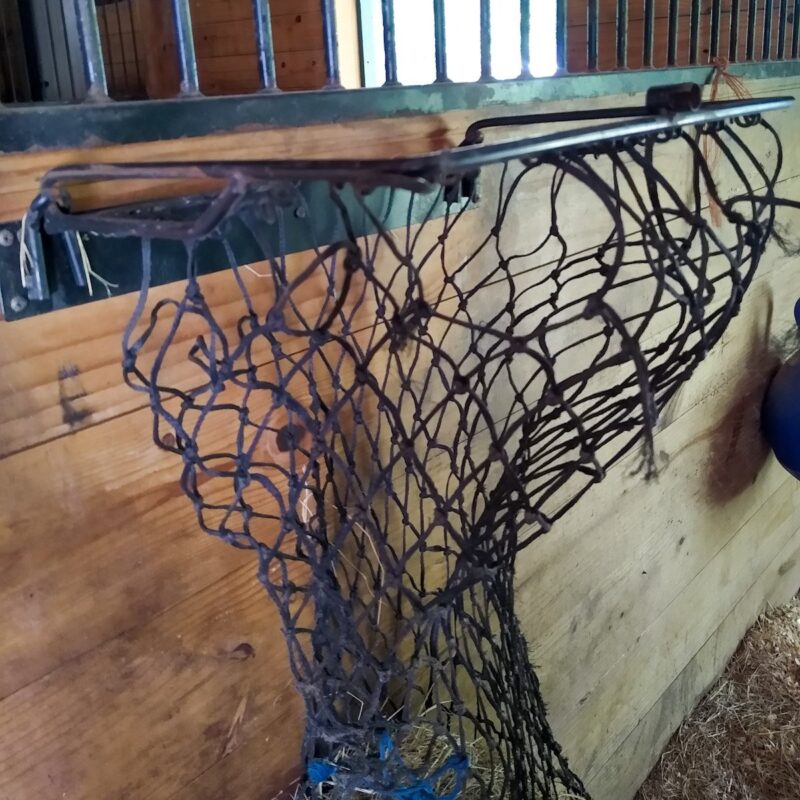
You can also clip or secure your hay net into another container. Use hay nets inside a trough for a DIY feeder option if your pasture doesn’t have posts for tying.
The simplest way to provide a hay net is to not attach it to anything at all. Hay nets on the ground offer the most appropriate grazing position, compared to tying them at or above wither height. To keep things safe, make sure that any drawstring ropes are safely tied or tucked out of reach of the horse before offering a hay net unsecured on the ground.
Don’t use hay nets at ground level if your horse has shoes.

How to Teach a Horse To Use a Hay Net
The right net and the right education are important for hay net success. Horses have to learn to eat from a hay net to avoid frustration – and busted nets.
These problems are the result of not picking the right net for the job. This is another reason to invest in good quality nets. A badly constructed or cheaply made haynet will rip or tear more easily.
Frustration with the net can trigger destructive behaviors. If your horse doesn’t have the skill or patience to eat from a net with small holes, they’re more likely to abuse their hay net. Tearing holes or throwing around hay nets are signs of frustration.
Tearing holes in hay nets can become a habit. Improper hay net use can also cause dental problems, so it’s important that you teach your horse to use their hay net correctly.
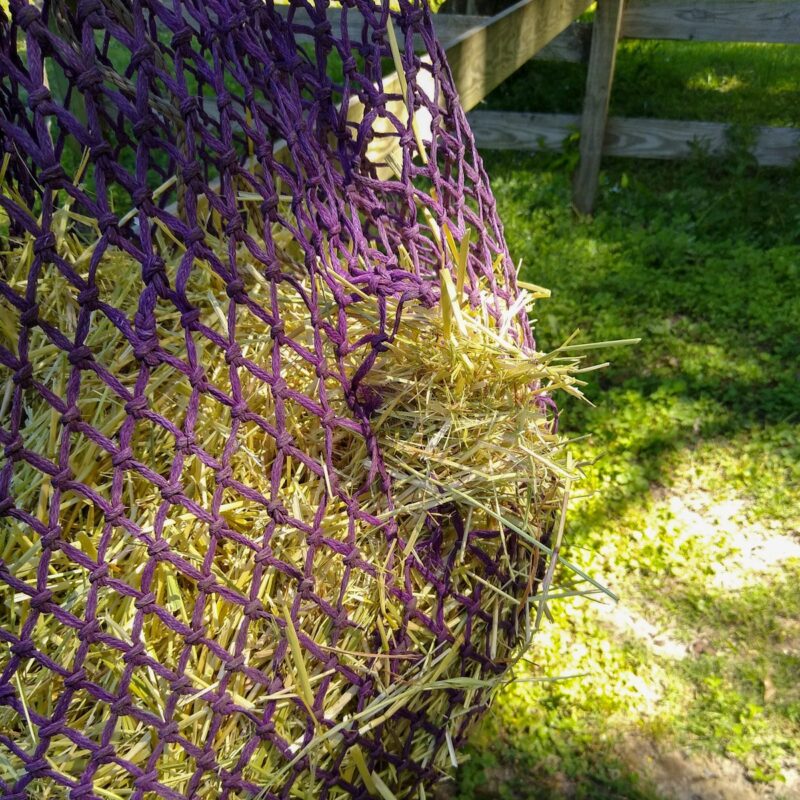
Starting with a Large Hole Hay Net
The best way to set horses up for hay net success is to start with large holes and gradually switch to nets with smaller and smaller holes. If your horse is new to hay nets or has bad hay habits, start with large openings.
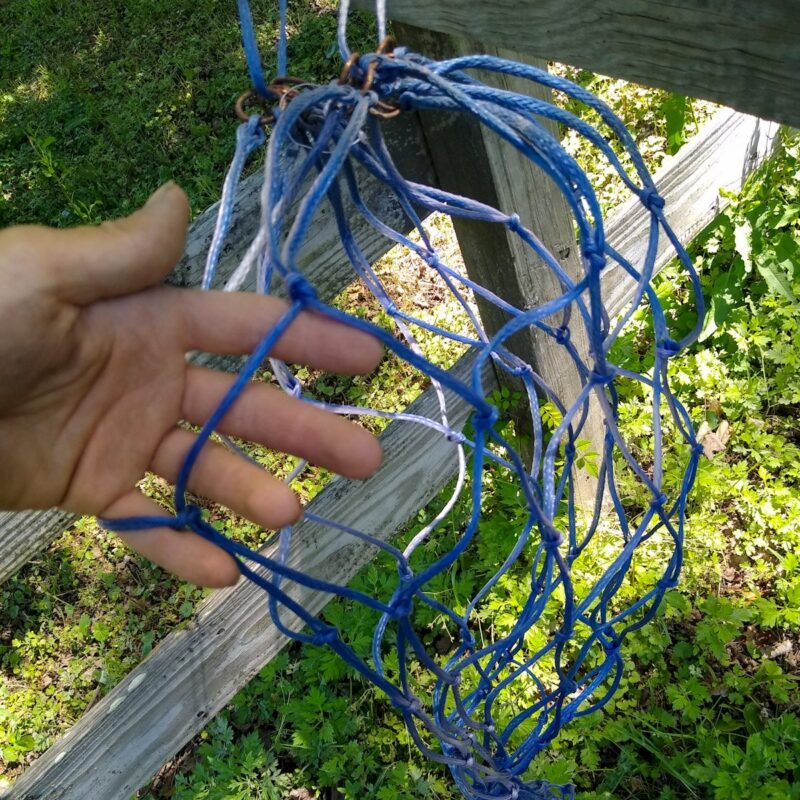
If your horse is new to hay nets, or you’re re-teaching a horse with bad haynet behavior, use the large-hole net for a few days. Observe your horse as they eat and see how they respond to the net. After a few days, they’ll probably be ready for a smaller size.
The good news is that hay nets with larger holes – four inches or so – are inexpensive. It’s a good investment in better hay net habits.
Switching to a Small Hole Hay Net
When your horse seems comfortable with using a net with very large holes, move to the next size down. If you were using a 4-in hole net, you might consider a 2-inch opening size. 2 x 2 inch nets are the most common net available, but there are also hay nets with 3 inch openings.
Use the new hay net for a few weeks. Watch your horse eat to see if they’re adjusting to the slower food intake. The right hay net behavior is gently tugging hay from the net in a grazing-like motion, and this takes practice.
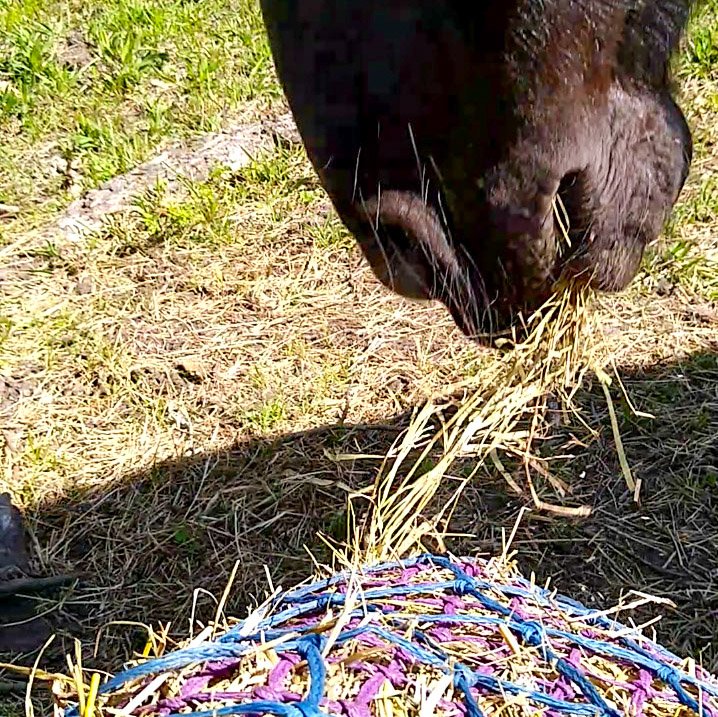
Continue moving down a size every few weeks until the hay lasts the correct amount of time. Remember that most horses need 1.5% to 2.5% of their body weight in forage each day. Weigh the day’s hay ration, and use a hay net that makes the hay last all day. Your goal is constant access to forage.
Some horses eat their hay slowly and only need a net with 2×2 inch mesh. Others need a smaller net to control their feeding rate. If your horse goes through hay too quickly or needs to lose weight, you may need an ultra slow feed net with very small holes. If your horse seems to be struggling with a small hole hay net, switch back to a larger size temporarily so that they don’t learn bad habits or associate hay nets with frustration and food anxiety.
Horses with Hay Net Problems
Check your hay nets frequently, even if you’re using a full bale net that doesn’t need daily filling. This lets you stay on top of any safety hazards, such as loose or frayed rope. You’ll also be watching for holes, which should be repaired right away. If you don’t repair holes promptly, your horse may learn that deliberately tearing a hole in the net lets them eat more hay.
If your horse consistently abuses small hole nets, they may be communicating that they need a slightly larger size or a different hay net setup. Sometimes even a small adjustment can make a difference! Try placing the hay net at a different height or in a different location in the pasture or stall. Address competition for forage, herd compatibility, or overall food/resource anxiety at the same time. Food anxiety or insecurity can trigger rushed eating, leading to damaged hay nets.
Safety and Use Concerns
Hay nets are usually very safe ways to feed forage to your horse, with a few important safety points.
If horse hooks a shoe into a hay net, they can become entangled or tear away the shoe – sometimes with part of the hoof – as they free themselves. If your horse wears shoes, you should place the net high enough that they can’t touch it with their hooves. The recommendation is usually to hang the net at or above wither height.
Hay nets can cause incisor or gum erosion in some horses. Repeated pulling and tugging on the rope or knots – especially with synthetic material – can cause damage to the teeth. However, many horses use nets for years without any damage to their teeth. Correct usage that involves the whiskers and lips more than the teeth helps prevent tooth damage. Check your horse’s mouth frequently and discuss any changes with your veterinarian.
Hay nets that are hung very high overhead can shower your horse with dust and bits of hay, causing irritation or allergic reactions. Extended use of nets tied high may also cause tension or soreness, as horses are designed to feed mostly from ground level. The best way to avoid both of these situations is to secure your nets as low as possible, keeping in mind the caution about shoes.
The other immediate safety hazard from hay nets is entanglement. Most haynets are held closed with a drawstring. Make sure that when the net is filled, the excess rope from the drawstring is either out of reach of the horse or is knotted and tucked away.
Hay Nets for Horses: A Win for Welfare
Hay nets are an excellent way to meet your horse’s need for forage while keeping their weight needs and your pocketbook in mind. They also provide an enriching experience, simulating slow grazing, even when horses can’t have abundant grass. Whether you’re new to hay nets or want to give them another try, picking the right net and training your horse to use it is the path to hay net success.